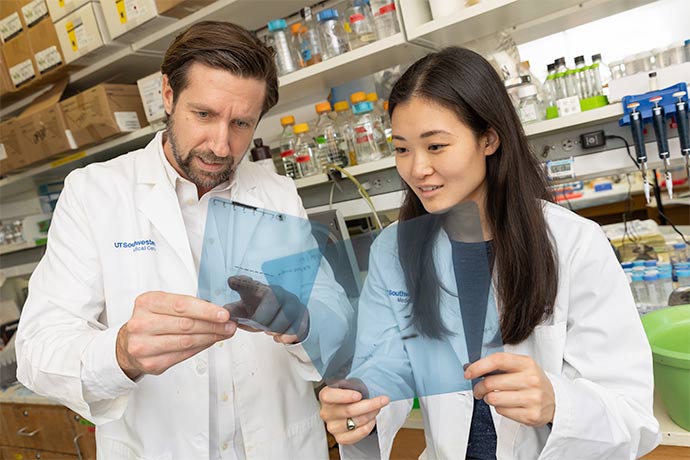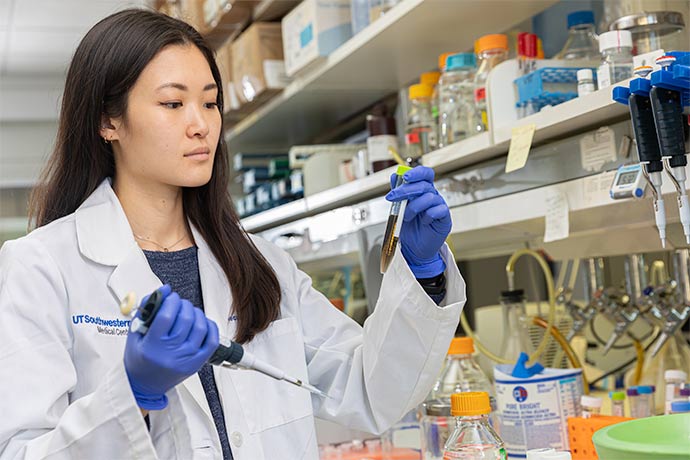Perot Family Scholars MSTP student receives Kirkpatrick Award for COVID-19 research

Perot Family Scholars Medical Scientist Training Program student Gina Park has won the 2022 William F. and Grace H. Kirkpatrick Award for her grant application related to the discovery of a capping mechanism that SARS-CoV-2, the virus that causes COVID-19, uses to disguise its genetic material.
The award is given annually to a UT Southwestern Graduate School of Biomedical Sciences student who submits the most scientifically meritorious National Institutes of Health fellowship or equivalent grant application during the prior academic year as judged by the Graduate School Awards Committee. The grant for Ms. Park’s research provides $30,000 to the lab of Vincent Tagliabracci, Ph.D., Associate Professor of Molecular Biology, to kick-start the proposed research.

“I’m incredibly honored to have been selected for this prize. I’d also like to acknowledge my mentor, Vinnie Tagliabracci, who has been so supportive throughout my time as a graduate student,” said Ms. Park, an M.D./Ph.D. candidate in the University’s Perot Family Scholars Medical Scientist Training Program and member of the Tagliabracci lab.
Her project is called “Investigating the RNA-Capping Mechanism of SARS-CoV-2 and other Nidoviruses.” Nidovirus is a type of RNA virus that includes the coronavirus family.
Ms. Park was co-lead author of a recent Nature study that revealed a long-elusive mechanism that coronaviruses, including the one that causes COVID-19, use to evade detection by the cells they infect. The virus creates a cap on one end of its RNA that mimics that of the cell.
“The RNA cap disguises the viral genome and allows the virus to hijack host cell machinery to produce its own viral proteins. Thus, it is crucial for the life cycle of the virus. My Kirkpatrick project builds upon this discovery to investigate whether this RNA-capping mechanism is conserved among a broad range of nidoviruses. This could be relevant in identifying a target for antivirals against not only SARS-CoV-2, but also other coronaviruses that cause human diseases,” she said.
Dr. Tagliabracci, a Howard Hughes Medical Institute Investigator and member of the Harold C. Simmons Comprehensive Cancer Center, is known for encouraging trainees to follow science into unexplored territory. The journey that resulted in the Nature study began in 2020 near the start of the pandemic, and the breakthrough experiments occurred about a year later. Ms. Park, who had noticed a possible similarity in the chemistry of the unconventional capping mechanism and that of a well-known reaction called AMPylation, suggested experiments to compare the two.
It took several months to complete the research, with Ms. Park reporting success in the summer of 2021, he said. Rather than celebrate, she and co-lead author Adam Osinski, Ph.D., then a graduate student, worked to replicate the findings.

“So, she went back and repeated the experiment, and thankfully, the results were reproducible,” Dr. Tagliabracci said. The lab held off on celebrating until the finding was accepted for publication in Nature.
“She had the courage to do the experiment – and good for her. I’m glad she did it,” he said, adding, “I encourage my trainees to take chances. If you have a good idea, just try it.”
Dr. Tagliabracci is a Michael L. Rosenberg Scholar in Medical Research.

